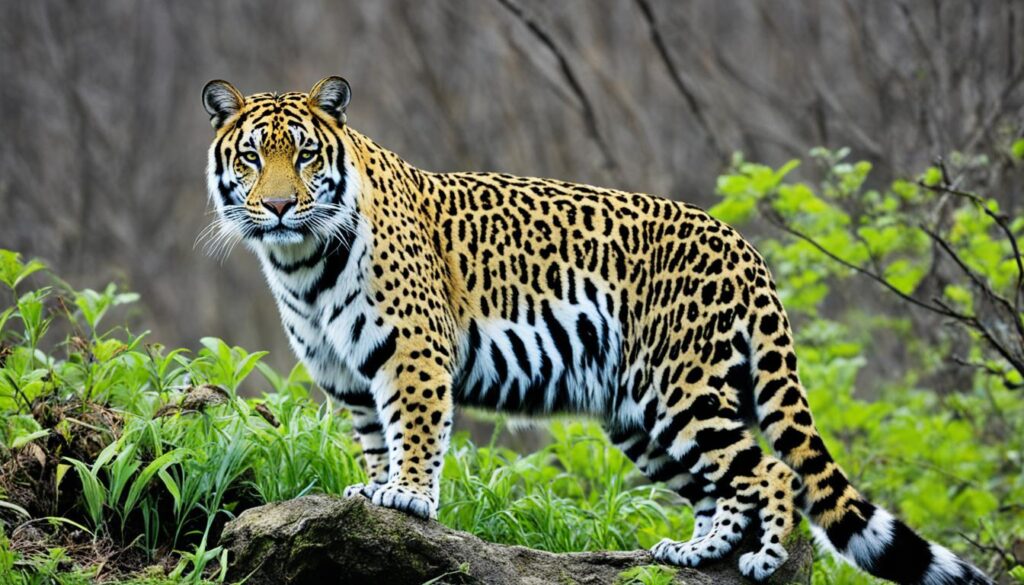Did you know that North Korea is home to a staggering 105 recorded mammal species? While none of these species are critically endangered, it is alarming to discover that seven are classified as endangered and six as vulnerable. This highlights the urgent need for conservation efforts to protect the precious fauna of North Korea.

Key Takeaways:
- North Korea is home to 105 mammal species, with seven classified as endangered.
- Conservation efforts are crucial to protect the diverse wildlife in North Korea.
- The demilitarized zone (DMZ) has become an unexpected wildlife sanctuary in the absence of human activity.
- The DMZ supports rare and endangered species and provides diverse ecosystems.
- Virtual exploration through Google Street View offers a unique glimpse into the beauty and ecological significance of the DMZ.
The DMZ as a Wildlife Sanctuary
The demilitarized zone (DMZ) in Korea, created as a buffer zone to maintain peace between North and South Korea, has inadvertently become a sanctuary for wildlife. Due to the restricted access and lack of human activity in the area, animals such as bears, cranes, deer, and otters have flourished.
The DMZ is home to a wide range of species, including several rare and endangered ones. In fact, it has been found to be particularly important for cranes, with seven out of the 15 crane species in the world found in the area. The diverse habitats within the DMZ, ranging from forests to wetlands, provide ideal conditions for these magnificent birds to thrive.
Animal Species in the DMZ
To give you a better understanding of the rich biodiversity found in the DMZ, here are some examples of animal species that call this wildlife sanctuary home:
| Animal | Scientific Name | Status |
|---|---|---|
| Korean black bear | Ursus thibetanus ussuricus | Vulnerable |
| Hooded crane | Grus monacha | Endangered |
| Red-crowned crane | Grus japonensis | Endangered |
| Manchurian wapiti | Cervus canadensis xanthopygus | Vulnerable |
| Asiatic small-clawed otter | Aonyx cinereus | Near Threatened |
The DMZ’s remarkable biodiversity and the presence of rare and endangered species highlight the importance of preserving this unique habitat. The absence of human interference in the area has allowed these animals to thrive, providing valuable insights into the natural resilience of ecosystems when left undisturbed.
The Environmental Recovery of the DMZ
The demilitarized zone (DMZ) is not only a testament to the ongoing tension between North Korea and South Korea but also a remarkable example of environmental recovery and ecological importance. With no human activity within its borders, the DMZ has become a haven for wildlife and a thriving ecosystem.
The DMZ encompasses various habitats, including mountains, swamps, lakes, and tidal marshes, providing a diverse range of ecosystems for numerous species. Researchers have documented the presence of animals such as long-tailed goral, musk deer, golden eagles, and a variety of plants and insects. This vibrant assortment of wildlife has made the DMZ an essential site for conservation efforts.
Despite its ecological significance, the preservation of the DMZ faces challenges due to the ongoing tensions between North and South Korea. The delicate balance between environmental recovery and potential disruption highlights the need for continued conservation initiatives and international cooperation to protect this unique and invaluable ecosystem.
Conservation Efforts in the DMZ
In response to the ecological importance of the DMZ, researchers, conservationists, and local and international organizations have been actively involved in initiatives to preserve and protect the area’s wildlife and natural habitats.
Efforts include:
- Collaborative research projects to better understand the diverse species within the DMZ and their ecological roles.
- Establishment of protected areas and nature reserves within the DMZ to safeguard critical habitats.
- Promotion of eco-tourism that emphasizes sustainable practices and educates visitors about the importance of preserving the DMZ’s environment.
- Advocacy for increased international recognition of the DMZ’s ecological significance and support for conservation efforts.
- Cooperation between North and South Korea to develop joint conservation initiatives that transcend political boundaries.
These conservation efforts not only contribute to the preservation of wildlife and ecosystems within the DMZ but also serve as symbols of hope for future environmental cooperation between nations.
Rare and Endangered Species in the DMZ
The demilitarized zone (DMZ) is a haven for rare and endangered species, showcasing the remarkable biodiversity of this unique area. Within the DMZ, there are 102 recorded species out of the 267 endangered species found on the Korean peninsula. Among these fascinating creatures are wildcats, yellow-throated martens, and Asiatic black bears, each facing significant conservation challenges. To capture evidence of their existence, remote cameras have been strategically placed, enabling us to catch glimpses of these elusive animals in their natural habitat.

Not only does the DMZ provide refuge for endangered mammals, but it is also home to a variety of rare plants. The DMZ Botanic Garden, established as part of conservation efforts, has documented intriguing species like the Pogonia japonica, known for its delicate beauty and unique adaptations. Additionally, the Patrinia saniculifolia, a flower of symbolic significance, adds to the charm of the DMZ’s botanical diversity.
The Elusive Wildcat
The wildcat is one of the rarest and most endangered species found within the DMZ. With its elusive nature and nocturnal habits, spotting a wildcat in the wild is an extraordinary experience. Conservation experts believe that the DMZ’s protected environment offers a glimmer of hope for the survival and eventual recovery of this fascinating feline.
Diverse Wildlife Conservation Efforts
| Conservation Effort | Description |
|---|---|
| Camera Trapping | Remote cameras have been strategically installed to capture images of rare and endangered species, providing valuable data for conservation research. |
| Habitat Restoration | Various initiatives aim to restore and enhance habitats within the DMZ, ensuring a conducive environment for the survival of wildlife species. |
| Sustainable Management | The DMZ is managed sustainably with strict regulations and limited human interference, allowing species to thrive undisturbed. |
These conservation efforts demonstrate the commitment to preserving the natural heritage of the DMZ and its remarkable ecosystem. By safeguarding these rare and endangered species, we contribute to the broader conservation efforts in the Korean peninsula and beyond.
Exploration of the DMZ Through Google Street View
Google has partnered with South Korean cultural institutions to offer a groundbreaking virtual exploration of the DMZ through Google Street View. This innovative project allows people from around the world to access immersive 360-degree images of the restricted area, providing a unique opportunity to witness firsthand the natural landscapes and diverse wildlife within the DMZ.

The virtual exploration of the DMZ through Google Street View not only brings the beauty of this remarkable region to audiences across the globe but also commemorates the 70th anniversary of the armistice agreement that ended the Korean War. By using this technology, individuals can now experience the ecological significance of the DMZ and gain a deeper understanding of its environmental importance, all from the comfort of their own homes.
The Significance of the DMZ for Conservation
The demilitarized zone (DMZ) plays a crucial role in the conservation of wildlife and ecology on the Korean peninsula. This unique area with abundant biodiversity and a rich variety of species serves as a testament to the ecological importance of the DMZ.
The preservation of wildlife in the demilitarized zone is of utmost importance due to the presence of rare and endangered species. The untouched and undisturbed nature of the DMZ provides a safe haven for these animals to thrive.
Efforts made by researchers and conservation institutions within the DMZ contribute to broader conservation initiatives and highlight the need for preserving this precious habitat. By studying and protecting the wildlife and ecosystems in the DMZ, we can gain valuable insights into biodiversity conservation and habitat management.
In addition to its ecological importance, the DMZ symbolizes the delicate relationship between humanity and the environment. It demonstrates that even in the midst of geopolitical tensions, nature can prevail and thrive.
By raising awareness about the ecological significance of the DMZ, we can inspire and encourage similar efforts worldwide. The preservation of this unique habitat serves as a reminder of the importance of our relationship with the environment and the need for conservation on a global scale.
Conservation Initiatives in the DMZ
The conservation efforts within the DMZ are multifaceted and encompass various aspects, including:
- Monitoring and research: Scientists and researchers conduct regular studies to assess the biodiversity and ecological health of the DMZ. This information helps guide conservation strategies and management plans.
- Habitat restoration: Restoration projects aim to rehabilitate and enhance the natural habitats within the DMZ, preserving essential ecosystems and providing suitable environments for wildlife.
- Collaboration and education: Conservation organizations work together with local communities and governments to raise awareness, promote sustainable practices, and educate people about the importance of the DMZ’s conservation.
Through these concerted efforts, the conservation of the DMZ continues to make significant strides. However, ongoing geopolitical tensions pose challenges to the long-term preservation of this important wildlife sanctuary.
| Conservation Initiatives | Impact |
|---|---|
| Establishment of protected areas | To safeguard critical habitats and provide legal protection for endangered species within the DMZ. |
| International collaborations | Fostering cooperation between countries to support research, knowledge exchange, and joint conservation efforts in the DMZ. |
| Community involvement | Engaging local communities in conservation activities, promoting sustainable livelihoods, and fostering a sense of stewardship. |
Conclusion
The demilitarized zone (DMZ) in North Korea and South Korea has emerged as an unexpected haven for wildlife, providing a sanctuary for rare and endangered species that thrive undisturbed by human activity. The ecological significance of the DMZ is evident in its diverse habitats, which support a wide array of animals and plants. This makes the DMZ an invaluable site for conservation efforts.
Projects like Google Street View offer a unique opportunity to explore the DMZ virtually, allowing individuals worldwide to witness its natural beauty and gain a deeper understanding of its importance. Through these initiatives, people can appreciate the significance of preserving this ecologically rich area.
The DMZ represents not just a physical border but also a powerful symbol of the intersection between humanity’s tragic history and its potential for ecological vision. By recognizing the vital role the DMZ plays in the conservation of wildlife and ecosystems, we can learn from this unique environment and strive to protect and preserve similar habitats around the world.
